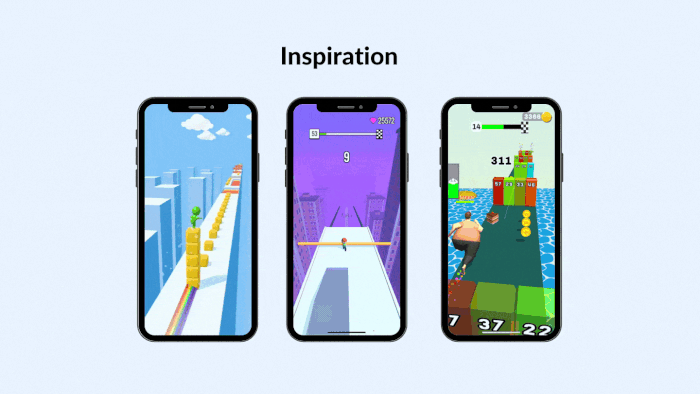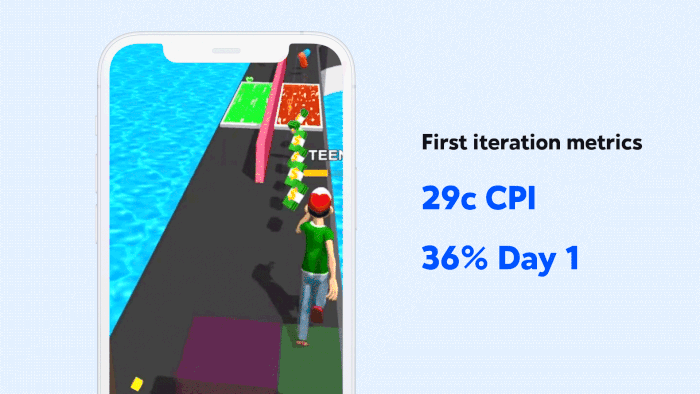· 10 min read
Run of Life: Ideation Tips for Creating Viral Games
Editor’s note: This article was originally written by the brilliant minds at Voodoo. They’ve agreed to share the story with us here, but head over to their blog if you want to see the original.
Run of Life is the brand new hit game developed by Tarek Mongy, a solo-dev based in Cairo. Transforming the popular stacking trend into a super relatable concept, the team hit over 20 million views on TikTok, generating a huge number of organic installs even before the game was officially launched. We sat down with Tarek and Jill, Publishing Manager at Voodoo, to take a closer look at the game as well as their tips on how to come up with viral and mass-market ideas for your next prototype.

Ideation Fundamentals
Your ideation process is key to creating hot prototypes. The more you prototype, the more chances you have of creating a hit, but it can be tricky to come up with brand new ideas in the hyper-casual space. Innovation drives successful ideation, and original ideas will help your game stand out from the crowd and make it to the top charts. Coming up with highly marketable and original ideas is largely dependent on trends – studios often look at what’s hot on the internet and social media right now as a way to find inspiration. We really focus on this at Voodoo, providing you with the latest insights when it comes to trends and virality to help you ideate in the right direction.
If we look at Run of Life, we can see that the idea itself combines a successful stacking mechanic with an original and super relatable concept: age-morphing. In the game, your goal is to make it to heaven by ageing as little as possible throughout the level, choosing between various objects and obstacles that will either make you older or younger as you progress. The game uses a simple slide control to move your player, and the core of the gameplay lies in making snap decisions that create either satisfaction or frustration throughout the level. Thanks to the super relatable concept and strong execution, it wasn’t long before Run of Life was trending on social media platforms such as TikTok, generating millions of views on its videos and hundreds of organic downloads even from the very first iteration.

So how did this idea come about? And how did the teams transform this idea into a hit game? Tarek and Jill have put together four top tips from their experience to inspire you for your next prototypes.
Tip #1: Don’t just follow a trend, create your own⚡️
Jill: “When you’re looking to apply the concept of ‘change the toy, keep the rules’, you need to make sure that you’re not falling into the trap of simply re-skinning a game that already exists. Introducing something new is essential to standing out from the crowd and transforming a current trend into something fresh. There are several ways to do this, but my top tip would be to think of a toy or theme that will create a different reaction for the player in some way. This can either be through the level design, the environment, or any features within the game. By creating a new feeling, players will be able to differentiate your game from ones they may have played before which use the same mechanic or control”.
Run of Life is a great example of a super original gameplay inspired by current trends. We can see the influence of the stacking mechanic as seen in games such as Spiral Roll or Cube Surfer, horizontal stacking as seen in Roof Rails, and finally the body transformation theme seen in games such as Strong Pusher. But Tarek was able to dig deeper into these trends, twisting the narrative to stand out from the others. Its secret to success? Relatability. Ageing is a theme that everyone in the world can relate to, and is previously unexplored in hyper-casual.
Tarek: “For me, I like to look at current hyper-casual trends, but there’s a really fine line between being inspired by trends and copying other games that are coming out. I was really inspired by Strong Pusher for this game but I wanted to come up with a concept that absolutely everyone could relate to. So that’s how I came up with the age thing – everyone can relate to going from a baby to an old person! That’s where the inspiration came from”.

Tip #2: Keep it simple 👍
Jill: “Another thing to keep in mind during the ideation process is to keep things as simple as possible. Hyper-casual gamers don’t want to think too much when they’re playing! They generally want the experience to be as straightforward as possible. The easier you make it for them the better, and one of the best ways to ensure you’re doing this is to keep things super simple during the ideation process, focusing on the core gameplay and not adding too many extras. This is essential to hitting the right metrics for launch”.
Keeping things simple is a golden rule in hyper-casual. Your game’s metrics in the prototype phase determine how clear your gameplay is, how universally understandable it is, and how easy it is for the user to pick up and play. Tarek focused solely on the core gameplay and mechanic for the first iteration. He applied a simple slide control, several clear objectives and obstacles, and a well-structured level design so as not to overwhelm the player. The first prototype only had 10 levels on an infinite loop, which allowed him to focus more on perfecting the gameplay clarity and simplicity.
Tarek: “A lot of my ideation process is picking up on best practices from successful games that have been published before. One thing I found really helpful in terms of level design was to look at games like Cube Surfer and map out their level structures to help get the right balance between simplicity and fun. I literally played several games with a pen and paper, mapping out each level to pick up on what was done well, and what to avoid in my own level design.”

With a super simple core gameplay and careful rhythm in the level design, Run of Life achieved a 29c CPI and 36% Day 1 in just the first round of testing.
Tip #3: Tell a small story, but keep it relatable ✏️
Jill: “It’s always a plus to tell a story through your game by adding a nice narrative. This gives context to the gameplay and allows players to connect more with the game. To do this, you need to make sure that all elements in the game are relevant and correlate with the narrative or overarching theme that you’re conveying”.
The story that drives Run of Life is to collect objects and avoid obstacles to be as young as possible by the end of each level in order to climb the stairs and reach heaven. This concept is super relatable, but the teams AB tested various objects and elements within the game to ensure they were as relevant to the narrative as possible. It’s a mix between reality and fantasy – unfortunately using skin products and doing yoga doesn’t actually make us younger in real life – so finding the right objects was super important to make the decisions clear cut for the player.
Tarek: “For this game especially, I tried to create a bit of a story around it to make sure that everything was coherent with the narrative. For example, even though most hyper-casual games use coins and gems for currency, it felt more natural to use cash in Run of Life as it felt more relatable to real-life situations!”
Tip #4: Think about the future 🔮
Jill: “Although you should always keep the gameplay as simple and understandable as possible in the ideation and prototype phases, you should also project yourself into the future and think about how much creative autonomy your idea has. Think about what elements you can test in the future and what’s next for your game! This way, you’re always making sure you don’t run into a loophole of not being able to add more depth to the game because of any constraints”.
In hyper-casual, game development doesn’t stop once the game is launched. At Voodoo, we make sure that we keep working on new features, challenges, and levels in the live optimisation phase to make sure your game stays fresh and fun for both existing and new users. One way we help do this is to organise brainstorming sessions with our Marketing experts to come up with new ideas. For Run of Life, one of our Marketing Developers came up with the idea of adding binary life choices to the game, such as choosing between Netflix and yoga. This was originally a fun idea to test in ads, but it worked so well, helping the game sustain a low CPI even after launch, that we actually added it to the gameplay itself.
Tarek: “I always try to think about the future when ideating to see if there’s room for the game to grow. For example, I think about what kind of updates we can introduce or what elements we can add to the level design. This really helps filter my ideas. Some ideas will seem really cool and you’ll be really keen to try them out, but when you actually think about it further, you’ll realise that there’s not much growth potential there. I’ll spend an hour or so thinking about each idea, and if I can’t think of anything, then I’ll immediately scrap it”.

Advice for solo-devs 🎤
Some of our most successful hit games were created by solo developers! Before wrapping up, we asked Tarek for his advice on how to make it in the world of hyper-casual as a solo dev.
Tarek: “It’s easy to get demotivated in hyper-casual, let alone as a solo developer! It’s taken me two years to get a game published, and it’s not always easy along the way. But it’s really important to understand that it takes a while to get a feel for the industry. It’s a very specific type of game, and not like any other game you may have made before.
I’ve been testing games with Voodoo for a couple of years now and have learnt a lot from the live streams and other studios in their ecosystem, so I’d definitely recommend checking out all the content and live streams! And remember that with every prototype that you make, even if it sucks, you’ll learn something like how to create a new mechanic. After a few years, you naturally build up a lot of good code, assets, and of course experience, so it really does get easier the more and more prototypes you make! Try to make fun stuff, and just keep going!”
So there we have some key tips to help you ideate. A huge thank you to Tarek and Jill for participating, and congratulations on Run of Life’s success! If you want to watch the live stream in full, you can check it out right here!
Stay tuned for future live streams full of knowledge and advice to help you create the next hit game.
